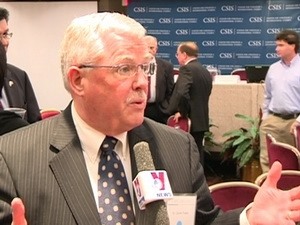 Politics & Law
Politics & Law

The unexpected breakdown of the second summit meeting between President Donald Trump and Chairman Kim Jong Un may be explained by two main factors.
 |
| Professor Carlyle A. Thayer. — VNA/VNS Photo |
* Carl Thayer
The unexpected breakdown of the second summit meeting between President Donald Trump and Chairman Kim Jong Un may be explained by two main factors.
First, it illustrates the limitations of Donald Trump’s top-down transactional approach to foreign policy.
Second, it illustrates that advanced preparations by both sides were inadequate and led to unrealistic expectations on the US side.
Ever since President Trump embarked on high-level summitry with North Korea, he has continually touted his “very special relationship” with his counterpart, Chairman Kim.
Both the first and second summit meetings were carefully choreographed to highlight the bonding between these two leaders, walks together on stately grounds and private one-on-one face-to-face meetings.
But can we seriously believe that in the space of a few hours of meetings that the two overcame linguistic and cultural barriers and really came to know and trust each other?
Prior to the summit, analysts reported that North Korea preferred the top-down approach because it gave Chairman Kim the aura of respectability.
After all, the Singapore summit was the first time the president of the United States had met with the leader of the Democratic People’s Republic of Korea.
Reportedly, after the Singapore summit North Korea delayed receiving Secretary of State Mike Pompeo and held pro forma working meetings with US Special Representative for North Korea Stephen Biegun.
In other words, Chairman Kim thought he could accomplish more in one-on-one discussions with President Trump than through lower level bilateral discussions.
The second summit in Hà Nội was arranged to duplicate the format of the first summit in Singapore.
The bilateral meetings between Trump and Kim were cordial and reportedly productive.
Discussions at lower level went right up to the eleventh hour.
They were characterised by Pompeo as productive as well.
It was publicly announced that the second summit would conclude with the signing of a joint statement.
Two hours before the final session it was clear than an impasse had been reached in the extended session and no joint statement was signed.
President Trump and Secretary Pompeo gave a press conference immediately after the summit ended.
Trump stated that the breakdown was basically about sanctions.
Trump also noted, “But at this time we had some options, and at this time we decided not to do any of the options.”
Secretary Pompeo noted that although real progress was made North Korea couldn’t go far enough to satisfy the United States.
Pompeo specifically mentioned that it was not possible for the US to convince their North Korean counterparts to “make a big step” towards denuclearisation. Finally, Pompeo concluded, “Unfortunately, we didn’t get all the way that ultimately made sense for the United States of America. I think Chairman Kim was hopeful that we would. We asked him to do more. He was unprepared to do that…”
The crux of the matter was that Chairman Kim’s offer to close down the Yongbyon nuclear test facility in exchange for the lifting of sanctions was viewed as insufficient by the US.
North Korea has since disputed that Chairman Kim demanded the lifting of all sanctions in exchange for closing down the Yongbyon nuclear test facilities.
Foreign Minister Ri Jong Ho said North Korea sought the lifting of five of eleven United Nations’ sanctions imposed in 2016-17 that impacted on the livelihood of North Korean people in return for the dismantling of the Yongbyon nuclear reactor and a written pledge to permanently end nuclear and long-range missile tests. "The US was not ready to accept our proposal," Ri stated. The US requested access to other facilities that North Korea kept secret.
South Korean sources reported that National Security Adviser John Bolton demanded North Korea disclose its chemical and biological weapons.
Trump noted the North Koreans did not know that the US knew about these facilities.
A sticking point of this magnitude should have been identified in working sessions prior to the summit.
President Trump defended his actions by stating that no deal was better than a bad deal.
This begs the question why a better deal hadn’t been drawn up in the first place.
According to the President’s Press Secretary the meetings between Trump and Kim were very good and constructive and that the two sides discussed various ways to denuclearise and “economic driven concepts.” This statement is an example of Trump’s facile transactional approach to dealing with North Korea – denuclearise completely in exchange for the opportunity to become an economic powerhouse.
President Trump and his senior officials have jumped on the idea that Việt Nam’s economic success could a model for North Korean to emulate. But history tells us to be cautious.
In January 1973, the US and the Democratic Republic of Việt Nam (North Việt Nam), among other parties, signed the Agreement on Ending the War and Restoring the Peace in Việt Nam.
Under the terms of this agreement, the US agreed to heal the wound of war. In February 1973, President Richard Nixon sent a private letter to Phạm Văn Đồng, the premier of North Việt Nam, offering to contribute US$3.25 billion of grant aid over five years to post-war reconstruction and an additional $1-1.5 billion in other forms of aid. Nixon’s letter proposed the establishment of a bilateral Joint Economic Commission (JEC) to administer funds for postwar reconstruction. JEC officials from both sides met in Hà Nội.
Total US funding for North Việt Nam roughly equalled the amount of aid that the Soviet Union and Eastern European countries were providing to Hà Nội at that time.
These sources of funding were incorporated into a draft of North Vietnam’s Second Five-Year Plan (1976-80) and would have represented a major lessening of North Việt Nam’s dependency on the Soviet Union.
US financial assistance to North Việt Nam’s postwar reconstruction never eventuated for a variety of reasons.
First, it is Congress not the president that authorises funding and in the wake of the Watergate scandal Nixon’s private commitment fell by the wayside. In 1975, the United States charged North Việt Nam with violating the 1973 Peace Agreement and withdrew from its obligations.
Later, in 1978, when the US and Việt Nam were on the verge of normalisation, Congress passed legislation prohibiting the use of US funds for “war reparations.”
The US and Việt Nam normalised relations in July 1995 and signed a bilateral trade agreement in 2000 but the path to full economic normalisation has still not been realised.
The US designates Việt Nam as a “non-market economy” thus imposing economic costs on Việt Nam’s exports. The United States has long-standing tariffs on Vietnamese catfish and shrimp, and the Trump Administration has imposed tariffs on Vietnamese aluminum and steel.
The Trump Administration inserted a “poison pill” into the yet to be ratified United States-Mexico-Canada Agreement (USMCA) permitting a signatory to withdraw if any of the other signatories signed a free trade agreement with a non-market economy.
This was aimed at China but poses a risk to Việt Nam as well. Under the terms of the 2018 Countering America’s Adversaries Through Sanctions Act (CAATSA), Việt Nam could be sanctioned for continuing to purchase military equipment and weapons from designated Russian defence entities.
President Trump’s transactional offer of denuclearisation in exchange for opening the door to North Korea to become an economic power house makes no mention of one major impediment – North Korea’s human rights record which would be an issue now that the Democrats control the House. The bipartisan Asia Reassurance Initiative Act (ARIA) requires the Trump Administration to report on its reasons for lifting sanctions on North Korea.
The breakdown of the second summit is a setback but not a disaster.
Kim promised Trump that he would not resume ballistic and nuclear testing.
Both sides agreed to continue negotiations at an unspecified future date. Perhaps it is time to give bottom-up diplomacy by the experts a chance.
Trump’s transactional high-level summitry appears to have run its course for the time being.
A third summit in 2020, a US election year, would appear more about show than substance.
In sum, Trump’s offer of a “bright shiny economic future” for North Korea is a grand transactional idea that needs to be defined and refined if it has any appeal to Chairman Kim. Given the track record of US-Việt Nam economic relations, Chairman Kim would be wise to consider whether President Trump can deliver.
And US negotiators need to go back to the drawing board and work out practical step-by-step measures that would build trust along the protracted path to denuclearisation of the Korean peninsula.
President Trump and his advisers need to curb their impatience at “big steps” and grand bargains.
The devil is in the details.
*Emeritus Professor, UNSW Canberra, The University of New South Wales
School of Humanities and Social Sciences at the Australian Defence Force Academy




